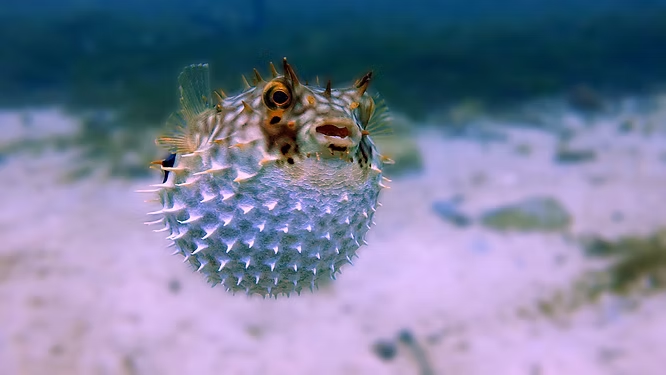Description and Behavior
The balloonfish (Diodon holocanthus), first described in 1758, is a porcupinefish species known for its distinctive ability to inflate its body when threatened. Also called the balloon porcupinefish, blotched porcupinefish, or spiny puffer, it is recognized by its large eyes, long spines, and comical balloon-like defense mechanism. Typically, individuals measure 20–35 cm but can reach up to 50 cm in length.
Balloonfish feature 13–15 dorsal and anal soft rays, and between 14–16 spines positioned from the snout to the dorsal fin. Juveniles display spotting on their underside, while adults develop dark blotches and dorsal spots. Distinctive markings include a brown bar above and below each eye, and another across the back of the head. When inflated, the fish’s sharp spines extend outward, deterring predators. Like other members of the family Diodontidae, balloonfish may also shift coloration when under stress or attack.
World Range and Habitat
Balloonfish are circumtropical, inhabiting warm marine waters across the globe. They are found in the Western Atlantic from Florida and the Bahamas to Brazil, in the Eastern Atlantic between 30°N and 23°S including South Africa, and in the Eastern Pacific from southern California to Colombia and the Galapagos Islands, as well as Hawaii, Pitcairn, and Easter Island.
Preferring coral reef ecosystems, balloonfish occupy depths between 2 and 100 meters, where rocky crevices provide essential shelter during daylight hours.
Feeding Behavior
Primarily nocturnal hunters, balloonfish emerge at night to feed. Their fused teeth form a powerful beak-like structure designed for crushing the hard shells of snails, sea urchins, and hermit crabs. Despite being poor swimmers, their specialized diet gives them an ecological niche within reef systems.
Juveniles face predation from large pelagic fish such as tuna and marine mammals like dolphins. Adult balloonfish, though better protected by spines and inflation, can still fall prey to sharks.
Life History
Balloonfish are dioecious, with separate male and female individuals. They reproduce externally, with a seasonal spawning peak each year. During mating, males slowly guide females toward the surface to release buoyant eggs, which hatch after approximately four days.
Larvae are highly developed at birth, equipped with eyes, a mouth, and a swim bladder. Initially yellow with scattered red spots, they are protected by a thin shell for about ten days before their spines emerge. By three weeks, fins, fin rays, and teeth are formed. Juveniles often drift among floating Sargassum weed, where their spotted underside provides camouflage. As they mature, they develop olive to brown coloration with dark blotches, transitioning into reef habitats as adults.
This unusual combination of inflation, spiny defenses, and specialized reproduction makes the balloonfish a distinctive member of tropical reef ecosystems worldwide.

